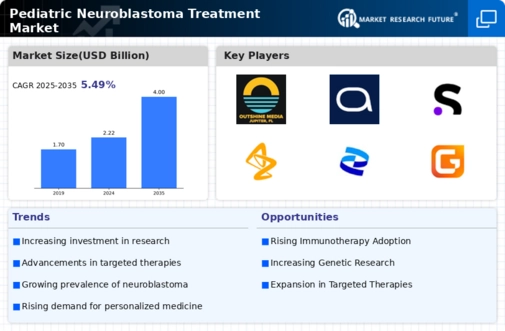Growing Awareness and Advocacy
Growing awareness and advocacy for pediatric cancers, particularly neuroblastoma, is significantly impacting the Pediatric Neuroblastoma Treatment Market. Advocacy groups and organizations are working tirelessly to educate the public and healthcare professionals about the disease, its symptoms, and the importance of early detection. This heightened awareness is likely to lead to increased diagnosis rates and, consequently, a greater demand for treatment options. Furthermore, campaigns aimed at raising funds for research and support services are gaining traction, which may result in more resources being allocated to the Pediatric Neuroblastoma Treatment Market. As awareness continues to grow, it is anticipated that more families will seek out advanced treatment options, thereby driving market growth.
Rising Incidence of Neuroblastoma
The Pediatric Neuroblastoma Treatment Market is experiencing growth due to the rising incidence of neuroblastoma among children. Recent statistics indicate that neuroblastoma accounts for approximately 7-10% of all childhood cancers, with an estimated 700 new cases diagnosed annually in the United States alone. This increasing prevalence necessitates the development of effective treatment options, thereby driving demand within the market. As awareness of neuroblastoma grows, healthcare providers are more likely to seek innovative therapies, contributing to the expansion of the Pediatric Neuroblastoma Treatment Market. Furthermore, the need for early diagnosis and intervention is becoming increasingly recognized, which may lead to enhanced treatment protocols and increased investment in research and development.
Innovations in Treatment Modalities
Innovations in treatment modalities are significantly influencing the Pediatric Neuroblastoma Treatment Market. The introduction of novel therapies, such as targeted agents and immunotherapies, has transformed the treatment landscape for neuroblastoma. For instance, the use of monoclonal antibodies and CAR T-cell therapies has shown promising results in clinical trials, leading to improved survival rates. The market is projected to witness a compound annual growth rate (CAGR) of around 8% over the next few years, driven by these advancements. As new treatment options become available, healthcare providers are likely to adopt these innovative therapies, further propelling the growth of the Pediatric Neuroblastoma Treatment Market. This trend underscores the importance of ongoing research and development in the field.
Increased Funding for Pediatric Cancer Research
Increased funding for pediatric cancer research is a crucial driver of the Pediatric Neuroblastoma Treatment Market. Government and non-profit organizations are allocating more resources to combat childhood cancers, including neuroblastoma. For example, initiatives such as the National Cancer Institute's funding programs aim to enhance research efforts and develop new treatment strategies. This financial support is vital for advancing clinical trials and bringing new therapies to market. As funding continues to rise, it is expected that the Pediatric Neuroblastoma Treatment Market will benefit from a surge in innovative treatment options and improved patient outcomes. The collaboration between public and private sectors is likely to further enhance research capabilities and expedite the development of effective therapies.
Regulatory Support for Pediatric Drug Development
Regulatory support for pediatric drug development is emerging as a key driver in the Pediatric Neuroblastoma Treatment Market. Regulatory agencies are increasingly recognizing the need for tailored therapies for children, leading to the establishment of guidelines that facilitate the development and approval of pediatric treatments. Initiatives such as the Pediatric Research Equity Act in the United States encourage pharmaceutical companies to invest in research for pediatric indications. This regulatory environment is likely to foster innovation and expedite the availability of new therapies for neuroblastoma. As a result, the Pediatric Neuroblastoma Treatment Market may experience accelerated growth, with more treatment options becoming accessible to patients in need.


















Leave a Comment